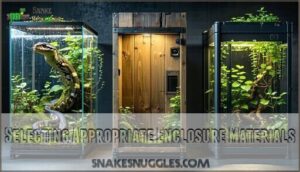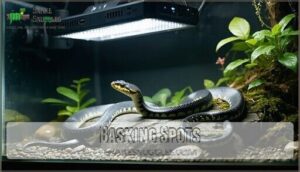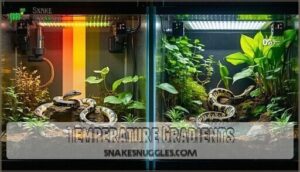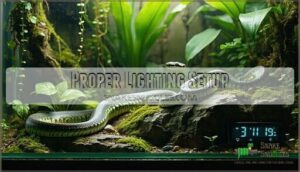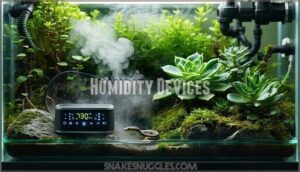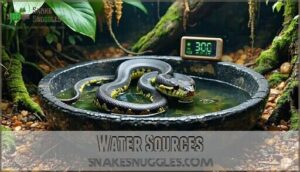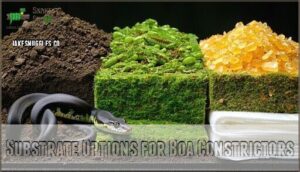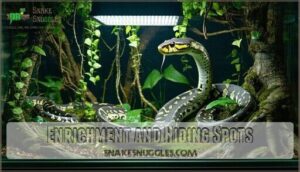This site is supported by our readers. We may earn a commission, at no cost to you, if you purchase through links.
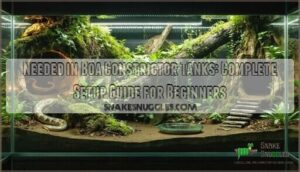
Start with a secure enclosure that’s at least 6 feet long for adults, featuring proper heating elements like ceramic heat emitters or under-tank heaters to maintain temperatures between 78-88°F.
You’ll need hiding spots on both warm and cool sides, a large water dish for soaking, and appropriate substrate like cypress mulch or paper towels.
Don’t forget humidity gauges, thermometers, and climbing branches since boas enjoy vertical space.
Getting the foundation right means the difference between a surviving snake and a thriving one.
Table Of Contents
- Key Takeaways
- Choosing The Right Enclosure Size
- Selecting Appropriate Enclosure Materials
- Essential Heating Elements
- Proper Lighting Setup
- Maintaining Optimal Humidity Levels
- Substrate Options for Boa Constrictors
- Enrichment and Hiding Spots
- Frequently Asked Questions (FAQs)
- What do boa constrictors need in their tanks?
- What is the best enclosure for a boa constrictor?
- Are boa constrictors high maintenance?
- What is the minimum enclosure for a boa constrictor?
- What do boas need in their tank?
- What do I need for a boa enclosure?
- What tank does a common boa constrictor need?
- What is the best setup for a boa?
- How do I safely handle a boa constrictor?
- What are common boa constrictor health issues?
- Conclusion
Key Takeaways
- You’ll need a spacious enclosure that’s at least 6 feet long for adults, with secure locks and proper ventilation to accommodate your boa’s growth throughout its 25-30 year lifespan.
- You must maintain precise temperature gradients using heat lamps and under-tank heaters, keeping the warm side at 88-92°F and cool side at 75-80°F for proper thermoregulation.
- You should provide multiple hiding spots on both warm and cool sides, along with climbing branches and enrichment items to encourage natural behaviors and reduce stress.
- You’ll need to monitor humidity levels between 55-75% using large water bowls, regular misting, and proper substrate like cypress mulch to prevent respiratory issues and shedding problems.
Choosing The Right Enclosure Size
Your boa’s enclosure size directly affects its health, behavior, and overall well-being throughout its lifetime.
The right enclosure isn’t just a home—it’s the foundation of your boa’s lifelong health and happiness.
You’ll need to plan for significant growth, starting with a 40-gallon tank for babies and upgrading to at least 6 feet long by 3 feet wide for adults, since these snakes can reach 8 feet in length and continue growing slowly for decades.
Baby Boa Requirements
Hatchling Enclosures for your baby boa constrictor need specific dimensions: 2’L x 1.5’W x 1’H works perfectly.
These compact spaces help juvenile boa constrictors feel secure while preventing stress from oversized environments.
Your juvenile boa will thrive with proper Handling Techniques – support their body gently and limit sessions to 10 minutes.
Establish a weekly Feeding Schedule with appropriately sized prey (10-15% of body weight).
Monitor their rapid Growth Rate closely, as juveniles shed monthly.
Watch for Common Issues like retained sheds or feeding refusal during this critical development phase.
Adult Boa Requirements
Your boa constrictor habitat transforms dramatically once your snake reaches adult size. These impressive reptiles demand serious space needs and thoughtful enclosure upgrades to accommodate their behavioral needs throughout their 25-30 year lifespan considerations.
Here’s your adult boa constrictor care checklist:
- Minimum dimensions: 6’L x 3’W x 3’H for standard adults, with proper temperature gradient zones
- Large specimens: 8’L x 4’W x 4’H for bigger boas weighing over 40 pounds
- Solo living: Never house multiple boas together—they’re territorial and stressed by roommates
- Security essentials: Install sturdy locks and maintain proper humidity levels to prevent escape attempts. Consider optimal heating conditions to maintain their health.
Selecting Appropriate Enclosure Materials
You’ll need to choose between glass, plastic, wood, or PVC materials for your boa’s enclosure, with each option offering distinct advantages for heat retention, visibility, and maintenance.
Glass terrariums provide excellent viewing and ventilation but may struggle with humidity control.
While wooden and PVC enclosures offer superior insulation and moisture retention that adult boas require, providing a suitable environment is crucial.
Glass Vs. Plastic Vs. Wood
Once you’ve determined your boa’s space requirements, choosing the right material becomes your next decision.
Each option presents distinct advantages worth considering carefully.
Glass tanks offer excellent visibility for monitoring your snake’s behavior, though they’re heavier and more expensive.
Plastic enclosures provide lightweight portability with decent insulation properties.
Wooden enclosures excel at temperature retention but require more maintenance effort.
To guarantee your boa’s well-being, consider the importance of mimicking their habitat with the enclosure design.
| Material | Visibility | Weight | Cost | Insulation | Durability |
|---|---|---|---|---|---|
| Glass | Excellent | Heavy | High | Poor | Good |
| Plastic | Good | Light | Low | Fair | Excellent |
| Wood | Limited | Medium | Medium | Excellent | Fair |
Custom-Built Options
Building your own enclosure gives you complete control over material selection and size customization.
Custom builds let you create the perfect home tailored exactly to your boa’s unique needs.
DIY enclosures using PVC boards offer waterproof durability, while sealed wood enclosures provide excellent insulation.
Unlike standard glass terrariums or plastic enclosures, custom builds let you create perfect dimensions for your boa’s growth.
Proper ventilation is essential for preventing respiratory issues.
Cost analysis shows DIY projects often save money long-term.
Focus on proper ventilation, secure locks, and heat gradients during construction.
Aesthetic design matters too—incorporate natural elements like branches and foliage to create an appealing habitat that mimics your boa’s wild environment.
Essential Heating Elements
You’ll need proper heating elements to create the temperature gradient that keeps your boa constrictor healthy, with a warm basking area reaching 88-92°F and a cooler side maintaining 75-80°F.
Heat lamps, ceramic heaters, and under-tank heating pads work together to establish these critical temperature zones that allow your snake to thermoregulate naturally.
Basking Spots
Creating effective basking spots requires precise thermostat control to maintain ideal basking temperature between 88-90°F.
Position your halogen heat lamp 12-18 inches above a sturdy branch or rock for proper lamp distance. Choose heat-retaining surface materials like slate or ceramic tiles.
Your boa’s thermoregulation depends on accessing this warm basking area for healthy digestion and metabolism. This is because the basking spot helps them regulate their body temperature.
Temperature Gradients
Your basking spot sets the stage, but temperature gradients complete the thermal picture.
Think of your enclosure like a comfortable house – you need warm and cool rooms.
Maintain 88-92°F on the warm side and 75-80°F on the cool side.
This gradient importance allows natural thermoregulation through snake heating zones.
Your boa constrictor temperature setup mimics their wild habitat perfectly.
Proper Lighting Setup
You’ll need to establish a proper lighting system that includes both UVB lighting and a consistent day/night cycle to support your boa’s natural biological rhythms and calcium metabolism.
Setting up the right combination of UVB bulbs and heat lamps on a 12-hour timer creates the foundation for a healthy, thriving snake that can properly process nutrients and maintain normal behavior patterns.
UVB Lighting
Your boa doesn’t strictly need UVB lighting for survival, but it offers surprising UVB benefits for immune support and natural behavior.
This support includes overall wellness, although UVB lighting is not mandatory for the boa’s survival.
T5 UVB bulb or T8 UVB bulb options work well, with 2-7% output being ideal.
Mount your chosen bulb types above the basking area for proper exposure, which supports this boa constrictor lighting setup.
Day/Night Cycle
Beyond UVB requirements, your boa needs a proper photoperiod length to stay healthy.
Set up a consistent day-night cycle using timers for your snake lighting options.
During active hours, provide full-spectrum lighting, then switch to dim infrared light during twilight hours.
The nighttime drop in illumination triggers natural behaviors and supports circadian rhythms.
Full-spectrum lighting benefits include enhanced color vibrancy.
Key lighting schedules include:
- 12-hour light cycles with gradual shifts
- Light spectrum changes from bright to dim
- Behavioral impact through consistent timing
- Health implications of disrupted sleep patterns, which can affect the overall health and well-being of your boa, and it is crucial to maintain a proper day-night cycle to ensure its well-being.
Maintaining Optimal Humidity Levels
You’ll need to maintain humidity levels between 55-75% in your boa’s enclosure, which requires careful monitoring and the right equipment to prevent respiratory issues and shedding problems.
Large water bowls, regular misting, and humid hides filled with damp sphagnum moss work together to create the stable moisture environment your snake needs for peak health.
Humidity Devices
With the right humidity control snakes thrive, and your toolkit starts with a digital hygrometer for precise monitoring within 1-2% accuracy.
Misters and Foggers deliver targeted moisture, while Automatic Systems handle scheduled adjustments without constant supervision.
Advanced Humidity Controllers integrate sensors for seamless regulation, and DIY Humidifiers using ceramic elements offer budget-friendly alternatives.
Professional fogger units provide ultrasonic fine droplets, while programmable mister systems maintain consistent humidity levels through wireless monitoring and memory recall features.
You can find a digital hygrometer available online.
Water Sources
Large water bowls serve as your boa’s primary hydration source and humidity powerhouse.
Choose a bowl that’s one-third your snake’s length, allowing full-body soaking during shedding.
Clean the water source weekly with reptile-safe disinfectant to prevent bacterial growth.
Supplement with distilled water misting twice weekly, focusing on substrate rather than your snake directly.
This misting frequency maintains proper humidity balance without oversaturating the enclosure.
Position the snake water bowl on the warm side for ideal evaporation and humidity distribution.
Using a digital hygrometer guarantees accurate readings.
Substrate Options for Boa Constrictors
You’ll need to choose the right substrate for your boa’s enclosure, as this foundation material affects humidity control, waste management, and your snake’s overall comfort.
Your options range from natural bioactive substrates like organic topsoil and sphagnum moss that create a living ecosystem, to practical alternatives such as aspen shavings, reptile carpet, or paper towels that simplify cleaning routines.
Bioactive Setups
Bioactive setups create a self-sustaining ecosystem that mimics your boa’s natural habitat.
Start with a proper drainage layer using hydroballs, then add bioactive substrate with organic topsoil and sphagnum moss.
Choose robust plants like pothos that thrive in high humidity.
Decomposer invertebrates including isopods and springtails break down waste naturally.
The cycling process takes weeks to establish ecosystem balance, but you’ll enjoy reduced cleaning and healthier conditions once everything’s working together.
Easy-to-Clean Alternatives
Not everyone wants the complexity of bioactive substrates.
Simple substrate options make your life easier while keeping your boa comfortable.
Here are three top choices:
- Paper towels – Replace weekly for effortless waste removal
- Reptile carpet – Machine washable and reusable for years
- Aspen shavings – Spot-clean soiled areas, replace monthly
These substrate options prioritize easy reptile tank cleaning over aesthetics.
Enrichment and Hiding Spots
You’ll need to create a stimulating environment that mimics your boa’s natural habitat, incorporating branches, driftwood, and artificial plants to encourage natural behaviors like climbing and exploring.
Providing multiple hiding spots, including a warm hide under your heat source and a cool hide on the opposite side, allows your snake to thermoregulate while feeling secure throughout the enclosure, which is crucial for its well-being and enables it to exhibit secure behaviors.
Natural Decor
Spruce up your Boa constrictor habitat with carefully chosen natural decoration that serves dual purposes. Safe Wood Types like manzanita and cork bark create perfect hide for boa spots while adding visual appeal.
Consider Plant Toxicity when selecting greenery—Pothos and Sansevieria work wonderfully. Strategic Decor Placement transforms your tank into a thriving ecosystem. Selecting appropriate wood is vital, so be sure to research suitable tank woods.
| Decor Type | Safe Options | Benefits |
|---|---|---|
| Plants | Pothos, Ficus, Sansevieria | Humidity control, natural aesthetics |
| Wood | Manzanita, cork bark, driftwood | Hiding spots, climbing opportunities |
| Rocks | Slate, granite (avoid limestone) | Rock Safety ensures secure basking areas |
Bioactive Benefits include improved air quality and reduced maintenance when live plants process waste naturally.
Climbing Structures
Your boa needs climbing structures to thrive like their wild cousins.
Branch selection matters—choose sturdy wood that won’t snap under weight.
Here’s what works best:
- Secure mounting prevents dangerous falls during boa exercise
- Vine types like artificial jungle vines create safe vertical enrichment
- Vertical space utilization maximizes climbing branches snakes actually use
These climbing structures transform sedentary pets into active, engaged arboreal snakes.
Frequently Asked Questions (FAQs)
What do boa constrictors need in their tanks?
Just like finding the perfect apartment, your boa needs specific essentials: a spacious enclosure matching their length, controlled temperatures (80-90°F), proper humidity (55-75%), secure substrate, water bowl, and enrichment for comfortable living.
What is the best enclosure for a boa constrictor?
Choose a 6’L x 3’W x 3’H enclosure for adult boas, though large females need bigger spaces.
PVC or custom-built wooden enclosures work best, offering proper insulation, humidity retention, and secure locking mechanisms.
Are boa constrictors high maintenance?
Think you’re ready for a low-maintenance pet?
Think again!
Boas aren’t exactly "set it and forget it" companions.
You’ll need precise temperature control, humidity monitoring, regular feeding schedules, and spacious enclosures—definitely more involved than goldfish.
What is the minimum enclosure for a boa constrictor?
Adult boas need at least a 6-foot long, 3-foot wide enclosure.
You’ll start with a 40-gallon tank for juveniles, then upgrade as they grow to their full 6-8 foot adult size.
What do boas need in their tank?
Your boa needs proper heating with basking spots at 88-90°F.
It also needs UVB lighting, secure hiding places, and climbing branches.
Provide an appropriate substrate like aspen shavings, a large water bowl, and maintain humidity levels between 55-75%.
What do I need for a boa enclosure?
You’ll need a proper-sized enclosure, heating elements, UVB lighting, thermostats, substrate, water bowl, hiding spots, and climbing branches. Essential equipment includes heat lamps, temperature gauges, and secure locks for safety.
What tank does a common boa constrictor need?
Forget that tiny "starter" tank – you’ll outgrow it faster than your snake.
Adult boas require minimum 6’L x 3’W x 3’H enclosures, while babies start in 40-gallon tanks.
Upgrade as they grow to prevent cramped, unhappy serpents, and ensure they have enough space to live happily.
What is the best setup for a boa?
You’ll want a 6-foot-long enclosure minimum, with basking spots at 88-90°F, cool areas at 75-80°F, 60-70% humidity, secure hides, climbing branches, and UVB lighting for peak health.
How do I safely handle a boa constrictor?
Support your boa’s body weight with both hands, moving slowly and confidently.
Avoid sudden movements that might startle them.
Never grab just the head or tail—they’re powerful constrictors who need gentle, respectful handling, and always remember to handle them with care.
What are common boa constrictor health issues?
Like a ship weathering storms, your boa faces health challenges.
You’ll encounter respiratory infections, mites, scale rot, and shedding problems.
Watch for wheezing, mouth breathing, tiny moving dots, discolored scales, or stuck shed requiring veterinary attention, especially signs like mouth breathing.
Conclusion
Studies show that properly equipped boa constrictors live 20-30% longer than those in inadequate setups, highlighting the critical importance of getting everything needed in boa constrictor tanks right from the start.
You’ve now learned the essential components required for creating a thriving environment for your serpent companion.
Remember, investing in quality equipment upfront saves money and stress later while ensuring your boa’s health and happiness.
Your snake depends on you to provide these fundamental necessities for a successful relationship.

